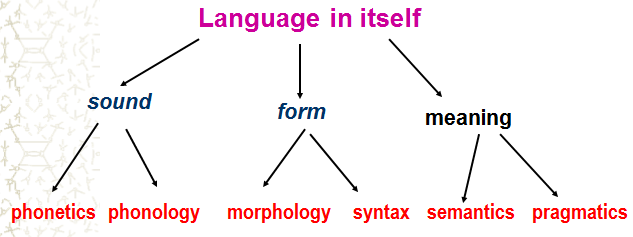知识点六:Linguistics: the scientific study of language
II. Linguistics as the science
(1)Definition of linguistics
Linguistics may be defined as the scientific study of language (Lyons, 1968).
(2)Object of linguistics
Spoken language (speech) vs. written language (writing)
Why is spoken language given priority to written language?
1st.Historically, speech is prior to writing in any cultures where writing exsits.
2nd.In terms of purpose, spoken language is used for a much wider range of purposes in communication.
3rd.Structurally, spoken language is structurally more complex than written language.
4th.In terms of order of acquisition, spoken language is acquired earlier than written language.
(3)Method of study
The scientific features of linguistic study: exhaustiveness, consistency, economy and objectivity.
Why linguistics is a scientific study?
Scientists generally work through a process similar to the following:

A conceptual framework of science as a process
The process of linguistic study can be summarized four steps:
Firstly, certain linguistic facts are observed, which are found to display some similarities, and generalizations are made about them.
Secondly, based on these generalizations, hypotheses are formulated to account for these facts.
Thirdly, the hypotheses are tested by further observations.
Finally, if the hypotheses are valid, a linguistic theory is constructed. If not, the researcher must reformulate hypotheses until no data collected contradicted the hypotheses.
III. Schools of linguistics
There are emerged two camps of linguistics, namely formal linguistics and functional linguistics.
Formal linguistics is based on the assumption that language is an autonomous system. The starting point is observing linguistics.
Functional linguistic is based on the view that language is as it is because of what it does. The starting point is observing how meaning is realized by lexicogrammar.
IV. Branches of linguistics
Overview:
The core branches of linguistics: Micro linguistics or Intra-disciplinary divisions
Other language-related disciplines: Macro-linguistics or Inter-disciplinary divisions
(1) Intra-disciplinary divisions
The study of language is often termed general linguistics. It is based on the view that language as a system is composed of three aspects: sound, structure and meaning. The study of all these aspects forms the core of linguistics.

(2) Inter-disciplinary divisions
1) Sociolinguistics
Sociolinguistics studies language in relation to society. Language and society are closely related.
The language a person uses often can reveal his social background.
Language changes are often caused by social changes.
2) Psycholinguistics
Psycholinguistics investigates the interrelationship of language and mind, in processing and producing utterances and in language acquisition. For example,
How do we produce and understand sentences?
How do children acquire their mother tongue?
How do we process the information we receive?
3) Applied linguistics
Applied linguistics refers to the application of linguistic principles and theories to language teaching and learning, especially the teaching of foreign and second language.
VI. Features of modern linguistics
Modern linguistics began in the early 20th century. Its founder is the Swiss scholar, Ferdinand de Saussure.
Features of modern linguistics
First, priority is given to spoken language.
Second, focus is on synchronic study of language rather than diachronic study of language.
Third, modern linguistics is descriptive and explanatory rather than prescriptive in nature.
Fourth, modern linguistics is theoretically rather than pedagogically oriented. Theoretical grammar and pedagogic grammar are complementary.
We have talked about linguistics. Next, let’s do some other exercises.
